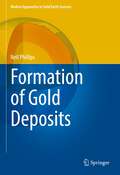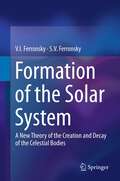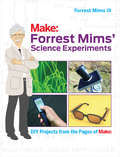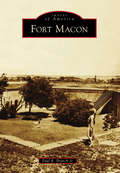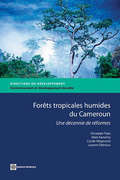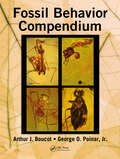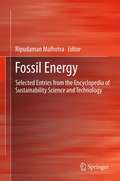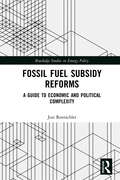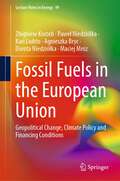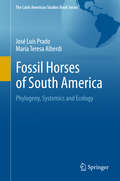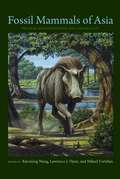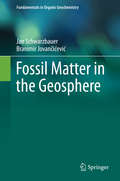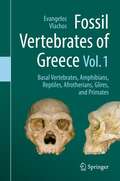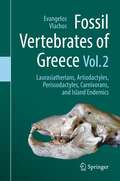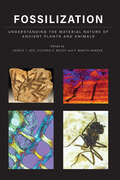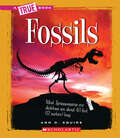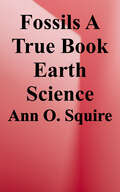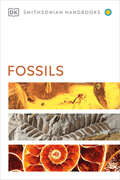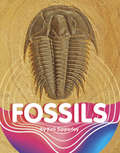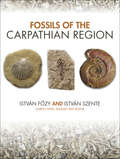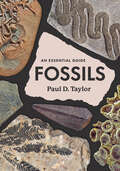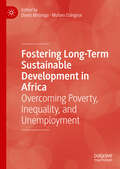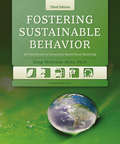- Table View
- List View
Formation of Gold Deposits (Modern Approaches in Solid Earth Sciences #21)
by Neil PhillipsThis book addresses the origin of gold deposits to answer questions of science and curiosity. These answers contribute in turn to the improved exploration and mining of gold. Initially there is a summary of the methods used to address the genesis of gold deposits including some of the essential science and concepts. Five basic observations follow that apply to many gold deposits and need to be considered in any genetic ideas. Magmatic processes enriching gold are discussed followed by the role of aqueous fluids during gold deposit formation at elevated temperatures and pressures. Modifying effects after deposit formation include high-grade metamorphism, retrogression, weathering, and erosion. The main types of gold deposits are then explained within the spectrum of viable genetic ideas, with informal names for these examples that include gold-only, gold-plus, Carlin, slate-belt, epithermal, porphyry, iron oxide copper gold, and Archean greenstone. Case histories are included in which the role of gold geology contributed directly to discoveries—one example is at the province-scale and another at the goldfield-scale. Unlike other books on the subject, this one addresses virtually all gold deposit types rather than focusing on one type in isolation. The primary readership includes industry geologists, senior undergraduates, postgraduates, and those with some knowledge of science and an interest in the gold industry.
Formation of the Solar System
by S. V. Ferronsky V. I. FerronskyAnalysis of the orbital motion of the Earth, the Moon and other planets and their satellites led to the discovery that all bodies in the Solar System are moving with the first cosmic velocity of their proto parents. The mean orbital velocity of each planet is equal to the first cosmic velocity of the Protosun, the radius of which is equal to the semi-major axis of the planet's orbit. The same applies for the planets' satellites. All the small planets, comets, other bodies and the Sun itself follow this law, a finding that has also been proven by astronomical observations. The theoretical solutions based on the Jacobi dynamics explain the process of the system creation and decay, as well as the nature of Kepler's laws.
Forrest Mims' Science Experiments: DIY Projects from the Pages of Make:
by Forrest M. Mims IIIForrest M. Mims is a revered contributor to Make: magazine, where his popular columns about science-related topics and projects for Makers are evergreen treasures. Collected together here for the first time, these columns range from such simple projects as building an LED tracker for hand-launched night rockets to such challenging builds as transforming strings of data into unique musical compositions.A variety of photography and imaging projects are featured, including an ultra-sensitive twilight photometer that measures the elevation of layers of dust, smoke, and smog from around 3,000 feet to the top of the stratosphere at 31 miles! Most of the projects can be done with a collection of simple electronic components, such as LEDs, transistors, resistors, and batteries. To inspire and motivate readers, the book also includes profiles of such famous Makers as President Thomas Jefferson and Microsoft co-founder Paul Allen.
Fort Macon
by Paul R. BranchSilently standing guard on the eastern point of Bogue Banks overlooking the entrance to Beaufort Harbor, Fort Macon is the centerpiece of one of the most visited North Carolina State Parks. Since Fort Macon State Park was established in 1924, it has been a familiar destination for millions of visitors to the "Crystal Coast" of Carteret County, North Carolina. The old historic fort itself, standing today in venerable repose, harkens back to another time in our country's history, however. At different times throughout its long, storied past, the fort has served as a US Army garrison post, a stronghold occupied for defense in three different wars, the scene of a desperate battle, a prison, and finally the second oldest state park in North Carolina. Fort Macon showcases this unique coastal fortification through historic images, highlighting not only its military past, but its role as a popular tourism destination through the years.
Forêts Tropicales Humides du Cameroun
by Carole Megevand Giuseppe Topa Laurent Debroux Alain KarsentyEn 1994, le gouvernement camerounais a initié des réformes légales et commerciales visant à réguler les droits d'accès et d'usage des forêts tropicales, qui constituent une richesse incontestable pour le pays. Ces réformes cherchaient à équilibrer les intérêts publics et privés et à plus largement intégrer les perspectives économiques, culturelles et environnementales. Aujourd'hui, plus de 60 pourcent des forêts tropicales du Cameroun sont exploitées selon un plan d'aménagement agréé. L'exploitation illégale dans les forêts aménagées a significativement diminué, la biodiversité est protégée plus efficacement et l'industrie forestière, restructurée, adhère largement aux pratiques de gestion durable reconnues internationalement. Basé sur des données historiques, des recherches spécifiques et des travaux analytiques, 'Forêts tropicale humides du Cameroun : Une décennie de réformes' présente la genèse et le déploiement de ces réformes. Ce livre identifie les politiques qui ont porté leur fruit, celles qui n'ont pas fonctionné et propose des améliorations. Bien que ces réformes aient été élaborées et mises en oeuvre dans un contexte spécifique, les enseignements tirés de cette expérience pourront servir à d'autres pays, connaissant des réalités similaires. Ce livre devrait être notamment utiles aux analystes politiques et experts du développement, ainsi qu'aux gouvernements, aux populations et aux agences de développement des pays riches en forêts tropicales, en Afrique et ailleurs.
Fossil Behavior Compendium
by Arthur J. Boucot George O. Poinar Jr.In this complete and thorough update of Arthur Boucot's seminal work, Evolutionary Paleobiology of Behavior and Coevolution, Boucot is joined by George Poinar, who provides additional expertise and knowledge on protozoans and bacteria as applied to disease. Together, they make the Fossil Behavior Compendium wider in scope, covering all relevant ani
Fossil Capital: The Rise of Steam Power and the Roots of Global Warming
by Andreas MalmHow capitalism first promoted fossil fuels with the rise of steam powerThe more we know about the catastrophic implications of climate change, the more fossil fuels we burn. How did we end up in this mess? In this masterful new history, Andreas Malm claims it all began in Britain with the rise of steam power. But why did manufacturers turn from traditional sources of power, notably water mills, to an engine fired by coal? Contrary to established views, steam offered neither cheaper nor more abundant energy--but rather superior control of subordinate labour. Animated by fossil fuels, capital could concentrate production at the most profitable sites and during the most convenient hours, as it continues to do today. Sweeping from nineteenth-century Manchester to the emissions explosion in China, from the original triumph of coal to the stalled shift to renewables, this study hones in on the burning heart of capital and demonstrates, in unprecedented depth, that turning down the heat will mean a radical overthrow of the current economic order.From the Trade Paperback edition.
Fossil Energy
by Ripudaman MalhotraThe word sustainability shares its root with sustenance. In the context of modern society, sustenance is inextricably linked to the use of energy. Fossil Energy provides an authoritative reference on all aspects of this key resource, which currently represents nearly 85% of global energy consumption. Gathering 16 peer-reviewed entries from the Encyclopedia of Sustainability Science and Technology, the chapters provide comprehensive, yet concise coverage of fundamentals and current areas of research. Written by recognized authorities in the field, this volume represents an essential resource for scientists and engineers working on the development of energy resources, fossil or alternative, and reflects the essential role of energy supplies in supporting a sustainable future.
Fossil Fuel Subsidy Reforms: A Guide to Economic and Political Complexity (Routledge Studies in Energy Policy)
by Jun RentschlerCountries around the world are spending up to $500 billion per year on subsidising fossil fuel consumption. By some estimates, the G20 countries alone are spending around another $450 billion on subsidising fossil fuel production. In addition, the indirect social welfare costs of these subsidies have been shown to be substantial – for instance due to air pollution, road congestion, climate change, and economic inefficiency, to name a few. Considering these numbers, there is no doubt that fossil fuel subsidies cause severe economic distortions that compromise countries’ prospects of achieving equitable and sustainable development. This book provides a guide to the complex challenge of designing, assessing, and implementing effective fossil fuel subsidy reforms. It shows that subsidy reform requires a careful balancing of complex economic and political trade-offs, as well as measures to mitigate adverse effects on vulnerable households and to assist firms with implementing efficiency enhancing measures. Going beyond the purely fiscal perspective, this book emphasises that smart subsidy reforms can contribute to all three dimensions of sustainable development – environment, society, and economy. Over the course of eight chapters, this book considers a wide range of agents and stakeholders, markets, and policy measures in order to distil the key principles of designing effective fossil fuel subsidy reforms. This book will be of great relevance to scholars and policy makers with an interest in energy economics and policy, climate change policy, and sustainable development more broadly.
Fossil Fuels in the European Union: Geopolitical Change, Climate Policy and Financing Conditions (Lecture Notes in Energy #99)
by Kari Liuhto Zbigniew Korzeb Paweł Niedziółka Agnieszka Bryc Dorota Niedziółka Maciej MrózThis book identifies scenarios for changes in transmission infrastructure, contracting, consumption patterns and fossil fuel financing policies, considering climate goals and the consequences of the conflict in Ukraine. The invasion of Ukraine by the Russian Federation has fundamentally changed the geopolitical situation, approaches to energy security issues, the EU’s energy (in)dependence and the implementation of previously outlined climate policies, including the planned gradual withdrawal from fossil fuels.This book presents the geopolitical architecture, energy mix, energy fuel supply structure, long-term energy policy and financing conditions of the oil and gas and sectors in the EU in the period preceding and following the Russian invasion of Ukraine. The authors consider the date of Russia’s attack on Ukraine as a symbolic caesura marking the beginning of the process of creating a new energy order in the EU. A novel part of the book is the attention it pays to the role of the credit and investment policy of the EU banking sector in relation to carbon-intensive sectors and to the significance of the financial system from the point of view of the effectiveness of international sanctions imposed on the Russian Federation, including, above all, sanctions related to the fossil fuel sector. The book is of interest to researchers and all those interested in learning about these subjects.
Fossil Horses of South America
by José Luis Prado María Teresa AlberdiThis book provides an update on the phylogeny, systematics and ecology of horses in South America based on data provided over the past three decades. The contemporary South American mammalian communities were shaped by the emergence of the Isthmus of Panama and by the profound climatic oscillations during the Pleistocene. Horses were a conspicuous group of immigrant mammals from North America that arrived in South America during the Pleistocene. This group is represented by 2 genera, Hippidion and Equus, which include small species (Hippidion devillei, H. saldiasi, E. andium and E. insulatus) and large forms (Equus neogeus and H. principale). Both groups arrived in South America via 2 different routes. One model designed to explain this migration indicates that the small forms used the Andes corridor, while larger horses used the eastern route and arrived through some coastal areas. Molecular dating (ancient DNA) suggests that the South American horses separated from the North American taxa (caballines and the New World stilt-legged horse) after 3.6 - 3.2 Ma, consistent with the final formation of the Panamanian Isthmus. Recent studies of stable isotopes in these horses indicate an extensive range of 13C values cover closed woodlands to C4 grasslands. This plasticity agrees with the hypothesis that generalist species and open biome specialist species from North America indicate a positive migration through South America.
Fossil Mammals of Asia: Neogene Biostratigraphy and Chronology
by Xiaoming Wang Lawrence J. Flynn Mikael ForteliusFossil Mammals of Asia, edited by and with contributions from world-renowned scholars, is the first major work devoted to the late Cenozoic (Neogene) mammalian biostratigraphy and geochronology of Asia. This volume employs cutting-edge biostratigraphic and geochemical dating methods to map the emergence of mammals across the continent. Written by specialists working in a variety of Asian regions, it uses data from many basins with spectacular fossil records to establish a groundbreaking geochronological framework for the evolution of land mammals. Asia s violent tectonic history has resulted in some of the world s most varied topography, and its high mountain ranges and intense monsoon climates have spawned widely diverse environments over time. These geologic conditions profoundly influenced the evolution of Asian mammals and their migration into Europe, Africa, and North America. Focusing on amazing new fossil finds that have redefined Asia s role in mammalian evolution, this volume synthe sizes information from a range of field studies on Asian mammals and biostratigraphy, helping to trace the histories and movements of extinct and extant mammals from various major groups and all northern continents, and providing geologists with a richer understanding of a variety of Asian terrains.
Fossil Matter in the Geosphere
by Jan Schwarzbauer Branimir JovančićevićThe first volume in this new text book series covers comprehensively relevant aspects related to the appearance and characterisation of fossil matter in the geosphere such as kerogen, oil, shales and coals. As organic geochemistry is a modern scientific subject characterized by a high transdisciplinarity and located at the edge of chemistry, environmental sciences, geology and biology, there clearly is a need for a flexible offer of appropriate academic teaching material on an undergraduat level addressed to the variety of students coming originally from different study disciplines. For such a flexible usage this textbook series' consists of different volumes with clear defined aspects and with manageable length.
Fossil Vertebrates of Greece Vol. 1: Basal vertebrates, Amphibians, Reptiles, Afrotherians, Glires, and Primates
by Evangelos VlachosThis 2-volume set provides a state-of-the-art study of the fossil record and taxonomy of the main vertebrate groups from Greece. Greece stands between 3 continents and its vertebrate fossil record is of great importance for paleontological and evolutionary studies in Europe, Asia and Africa. Fossils from classic, world-famous localities (e.g., Pikermi, Samos) form an essential part of the collections of the most important museums in the world and have been studied by numerous scientists. Recent paleontological research led to the discovery and study of numerous new sites. The volumes contain a taxonomic review of all named and identified taxa, their taxonomic history and current status, as well as historical, phylogenetic and biogeographic information. Volume 1 contains a synopsis of the fossil record and taxonomy of important groups of vertebrates represented in the fossil record of Greece. The volume deals with some of the early splitting clades, including the basal and enigmatic conodonts and basal tetrapods like fishes, amphibians, and reptiles like lizards, snakes, crocodiles, turtles and tortoises. The second part of the volume deals with basal mammalian clades, some of which are quite characteristic for the fossil record of the country: aardwarks, hyraxes, proboscideans, elephants and mammoths, sea cows, rodents, and lagomorphs. The volume ends with special chapters on the primate fossil record of the country, including some of our most recent and distant relatives.
Fossil Vertebrates of Greece Vol. 2: Laurasiatherians, Artiodactyles, Perissodactyles, Carnivorans, and Island Endemics
by Evangelos VlachosThis 2-volume set provides a state-of-the-art study of the fossil record and taxonomy of the main vertebrate groups from Greece. Greece stands between 3 continents and its vertebrate fossil record is of great importance for paleontological and evolutionary studies in Europe, Asia and Africa. Fossils from classic, world-famous localities (e.g., Pikermi, Samos) form an essential part of the collections of the most important museums in the world and have been studied by numerous scientists. Recent paleontological research led to the discovery and study of numerous new sites. The volumes contain a taxonomic review of all named and identified taxa, their taxonomic history and current status, as well as historical, phylogenetic and biogeographic information. Volume 2 contains a synopsis of the fossil record and taxonomy of important groups of mammals represented in the fossil record of Greece. The volume starts with specific chapters on laurasiatherians like insectivores and bats, moving on to the main part of the book that deals with three of the most important fossil groups in the country. The fossil record of even-toed animals is summarized with chapters on bovids, cervids, suoids, anthracotheres, hippos, giraffes, and tragulids. The fossil record of odd-toed animals is presented with special chapters on horses, tapirs, rhinos, and chalicotheres. The last part of this volume deals with meat-eating, carnivoran groups, like felids, viverrids, hyaenas, canids, bears, ailurids, mephitids and mustelids. The volume ends with a special chapter on insular endemic mammals from the various islands of Greece.
Fossilization: Understanding the Material Nature of Ancient Plants and Animals
by Carole T. Gee, Victoria E. McCoy, and P. Martin SanderAn in-depth look at the latest breakthroughs in our understanding of the material record that deep time leaves behind.Understanding the complex interplay of physical and chemical processes leading to fossilization is crucial to elucidating the 3800 million years of life on earth. And yet, the process of fossilization also leads to the loss of pivotal biological information, placing constraints on the very same understanding of ancient life it preserves. Over the last decade, however, remarkable advances in approaches, techniques, tools, and instrumentation have helped scientists to transcend these constraints by enabling high-resolution analysis of fossil material—even down to the nanoscale. Fossilization provides a critical look at these cutting-edge innovations in the science of fossil preservation and provides a road map for future research. Drawing from the fields of paleontology, organic and inorganic chemistry, microbiology, and high-resolution imaging and analysis, and spanning the diversity of life from plants to vertebrates and invertebrates, this resource details expert findings on• fossilization of hard and soft part tissues in dinosaurs• high-resolution chemical analysis of organic and inorganic tissues• arthropods preserved in amber• experimental silicification of wood• chemical defenses and color in fossil plants • confocal Raman spectroscopy• microprobe analysis• radioisotopic studies• and much moreA true interdisciplinary undertaking, the book is authored by paleontologists, mineralogists, geochemists, organic chemists, microbiologists, and materials scientists who have worked together to investigate questions around substance fossilization and the limits of the fossil record. A special color section contains SEM, Raman, and other striking images of vertebrates, invertebrates, and plants. Fossilization is a trailblazing reference book for research scientists and specialists in related fields, as well as for advanced undergraduates and graduate students interested in fossilization, emerging research techniques, and fresh approaches in the analysis of plant and animal fossils.Contributors: H. Jonas Barthel, Aurore Canoville, Carole T. Gee, Thorsten Geisler, Jens Götze, Conrad C. Labandeira, Sashima Läbe, Moritz Liesegang, Victoria E. McCoy, Martina Menneken, Jes Rust, P. Martin Sander, Frank Tomaschek, Torsten Wappler, Kayleigh Wiersma, Tzu-Ruei Yang
Fossils (A True Book (Relaunch))
by Ann O. SquireFossils are one of the most important tools we have for learning about long-extinct wildlife.A True Book: Earth Science series presents fascinating facts and fun activities that will engage the budding earth scientist, while exploring the fields of geology, meteorology, ecology, and more. This series includes an age appropriate (grades 3-5) introduction to curriculum-relevant subjects and a robust resource section that encourages independent study.In the 4.6 billion years since Earth was formed, many plant and animal species have come and gone. Readers will discover how fossils are formed, how paleontologists search for them, and what kinds of information they can provide.
Fossils (A True Book (relaunch): Earth Science Series)
by Ann O. SquireFossils are one of the most important tools we have for learning about long-extinct wildlife. A True Book: Earth Science series presents fascinating facts and fun activities that will engage the budding earth scientist, while exploring the fields of geology, meteorology, ecology, and more. <p><p>This series includes an age appropriate (grades 3-5) introduction to curriculum-relevant subjects and a robust resource section that encourages independent study. In the 4.6 billion years since Earth was formed, many plant and animal species have come and gone. Readers will discover how fossils are formed, how paleontologists search for them, and what kinds of information they can provide.
Fossils (DK Handbooks)
by DKThe clearest and sharpest recognition guide to over 500 invertebrate, vertebrate, and plant fossils from around the world. This comprehensive pocket guide is the perfect introduction to finding, identifying, and collecting fossils. It features more than 500 species of plant and animal fossils, from trilobites and megafauna to dinosaurs and ancient trees. This handbook cuts through the complicated identification process with expertly written and thoroughly vetted text that features precise description, enabling you to recognize a species instantly. Over 1,000 photographs, with illuminating annotations, help you pick out a fossil's chief characteristics and distinguishing features, while a color illustration shows the fossil as a living plant or animal. The detailed introduction explains what a fossil is and how they are classified. Start building your own collection with advice on where to look for fossils, what tools and safety equipment are needed for collecting, and how best to organize a fossil collection. To help you in the initial stages of identification, this book provides a visual identification key that makes it easy to recognize a fossil and place it in its correct group. Finally, a concise glossary gives instant understanding of technical and scientific terms.
Fossils (Earth Materials and Systems)
by Keli SipperleyPlants and animals from millions of years ago left behind fossils. Fossils can teach people about the past. They are also used for fuel. Discover why fossils are an important part of nature!
Fossils Tell of Long Ago (Let's-Read-and-Find-Out Science 2)
by AlikiWhat is a fossil?Sometimes it's the imprint of an ancient leaf in a rock. Sometimes it's a woolly mammoth, frozen for thousands of years in the icy ground. Sometimes it's the skeleton of a stegosaurus that has turned to stone.A fossil is anything that has been preserved, one way or another, that tells about life on Earth. But you can make a fossil, too—something to be discovered a million years from now—and this book will tell you how.
Fossils of the Carpathian Region (Life of the Past)
by István Szente István FozyA comprehensive review of the fossil record of the Carpathian Basin.Fossils of the Carpathian Region describes and illustrates the region’s fossils, recounts their history, and tells the stories of key people involved in paleontological research in the area. In addition to covering all the important fossils of this region, special attention is given to rare finds and complete skeletons. The region’s fossils range from tiny foraminifera to the Transylvanian dinosaurs and mammals of the Carpathian Basin. The book also gives nonspecialists the opportunity to gain a basic understanding of paleontology. Sidebars present brief biographies of important figures and explain how to collect, prepare, and interpret fossils.“An excellently written scientific book. . . . The good illustrations are an incentive to start reading and dive into the wide area covered by two experts in their respective fields. . . . A rich source of otherwise not published background knowledge on the paleontology and geology of the region.” —Christian A. Meyer, Natural History Museum, Basel“Fossils of the Carpathian Region . . . is beautifully produced with high-quality color illustrations throughout and an exhaustive bibliography and index. . . . Highly recommended.” —Choice“This book fills a gap in the geological texts on the Carpathians, especially in Hungary, and offers a valuable wealth of geological-paleontological and scientific-historical information from the Ordovician to the Pleistocene. This extensive and relatively inexpensive work is an unrivaled recommendation for amateurs and amateur geologists / paleontologists.” —Zentralblatt für Geologie und Paläontologie [translated from German]
Fossils: An Essential Guide
by Paul D. TaylorWith stunning images and an expert guide, explore the world of fossils to uncover the story of life on Earth, from the origins of new life to mass extinctions. Ancient Earth seems like an alien world. But the fossil record can help reveal the mysteries of the organisms that have lived on our planet since its formation some 4,600 million years ago. In this engaging and beautifully illustrated book, world-renowned paleontologist Paul D. Taylor provides a comprehensive guide to all aspects of fossils to tell the story of life on Earth. Taylor begins with the basics: how fossils form, how they mark geological time, and what they tell us about the origins of life and major evolutionary events like the Cambrian Explosion. He then shows the oldest fossils—single-celled bacteria in amazing, three-billion-year-old microbial rock structures—before introducing the first animals in the fossil record. From fishes to amphibians, reptiles, and mammals, we meet these animal fossils in an appropriate evolutionary parade. Next, we imagine plants long past, charting the evolution of this kingdom and learning how ephemeral botanical remains can become permanent records. While comprehensive in his coverage of fossil groups and ages, Taylor pays particular attention to specimens fossil hunters are most likely to encounter, like crinoids and the iconic ammonites. Throughout, he introduces us to fascinating fossil folklore—like the idea that ammonites are the petrified remains of coiled snakes—and helps us distinguish true fossils from fakes. With stunning color images of many original specimens from the collections of London’s Natural History Museum, Fossils is an essential introduction, connecting life on Earth today to the ancient past.
Fostering Long-Term Sustainable Development in Africa: Overcoming Poverty, Inequality, and Unemployment
by David Mhlanga Mufaro DzingiraiThis book provides a broad and insightful guide to the economic, social, and environmental concerns seen within Africa. It highlights the central economic challenges faced by African countries and outlines ways in which long-term sustainable development in Africa can be achieved. A particular focus in given to issues of poverty, inequality, and unemployment and how poor infrastructure, limited healthcare and education, and environmental deterioration are exacerbating these issues. By looking at the limited effectiveness of traditional development initiatives, a new framework for economic development is presented that focuses on community ownership and long-term sustainability and which acknowledges the history of colonisation, economic exploitation, and political instability that has held Africa back in the past.This book takes hope from countries within the Global South that have moved towards sustainable development and sets out ways in which other countries can follow them. It will be relevant to students, researchers, and policymakers interested in development and environmental economics.
Fostering Sustainable Behavior
by Doug Mckenzie-MohrTo attain a sustainable future, we must change many of our everyday actions. This completely revised and updated edition of Fostering Sustainable Behavior shows how community-based social marketing is key to overcoming barriers and resistance, and creating new social norms.
